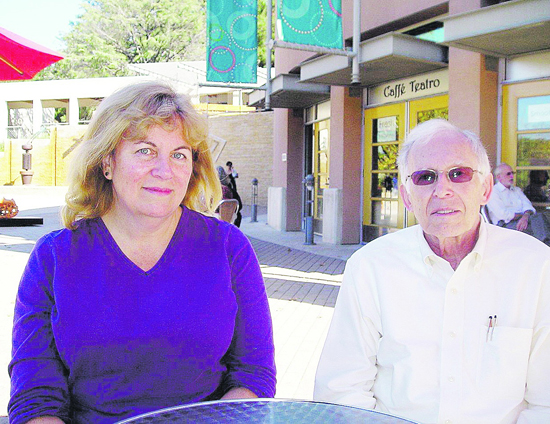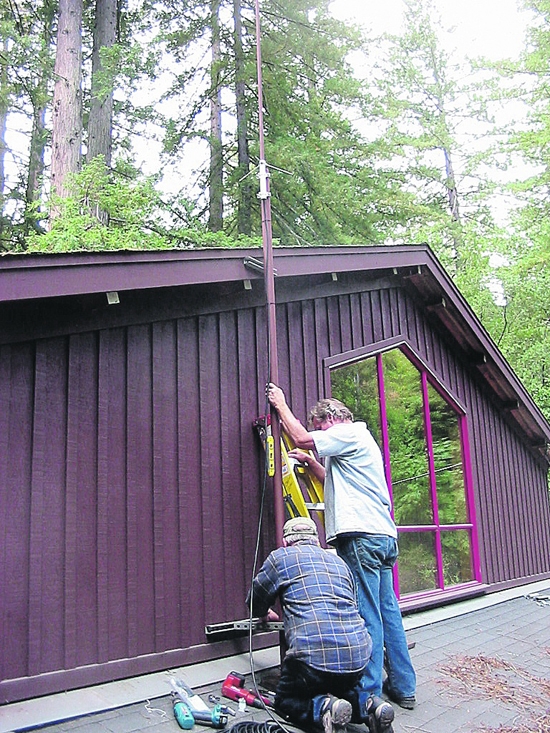| | Published November 9th, 2011
| Local "Hams" Take Their Job Seriously
| | Cathy Dausman |  | | Local amateur radio operators Leasa Raya and Gene Gottfried
Photo Cathy Dausman
|
Imagine a world without internet service, cell phones or land lines. It could be a temporary disruption, or one from a wind storm, earthquake or terrorist act. It could happen in Boston, or Seattle, or Miami. It did happen in New York, Washington D.C., Louisiana and Oklahoma City. It could even happen in Lamorinda. Now imagine communicating through technology that's more than a century old. You are imagining the wireless communication possible through amateur radio. Many local amateur radio operators, or "hams," act as volunteer emergency communicators. Here are some of their stories.
 Gene Gottfried is amateur KQ6OL. KQ6OL is his call sign. The FCC issues every licensed radio amateur a unique call sign that identifies the amateur and his/her location of license. Call signs have both a prefix (KQ6) and suffix (OL). The call sign number generally refers to an area of the country. And just as there are vanity license plates for cars, an amateur may request a vanity call sign.
Gene Gottfried is amateur KQ6OL. KQ6OL is his call sign. The FCC issues every licensed radio amateur a unique call sign that identifies the amateur and his/her location of license. Call signs have both a prefix (KQ6) and suffix (OL). The call sign number generally refers to an area of the country. And just as there are vanity license plates for cars, an amateur may request a vanity call sign.
 Gottfried has been an Orinda resident for 30 years. His neighborhood formed a watch group after a nearby home burglary in 1987, and Gottfried became a block captain. He recalls residents watching the ridgeline to assist the Tilden Fire Department during the 1991Oakland hills fire. In the early 1990's his neighbors used CB radios to communicate.
Gottfried has been an Orinda resident for 30 years. His neighborhood formed a watch group after a nearby home burglary in 1987, and Gottfried became a block captain. He recalls residents watching the ridgeline to assist the Tilden Fire Department during the 1991Oakland hills fire. In the early 1990's his neighbors used CB radios to communicate.
 The turning point for Gottfried came in 1996 when he attended Orinda's 4th of July parade. The Moraga Orinda Fire District (MOFD) Communications Van was there, and Gottfried was hooked. He says it is important for people to have some amount of preparation so they don't feel helpless in emergencies. Gottfried sees amateur radio as "a backup system for any disaster of any magnitude," whose membership cuts across age and gender. These days Gottfried carries a handy talkie or portable radio, keeps a mobile unit in his car and has a base station at home.
The turning point for Gottfried came in 1996 when he attended Orinda's 4th of July parade. The Moraga Orinda Fire District (MOFD) Communications Van was there, and Gottfried was hooked. He says it is important for people to have some amount of preparation so they don't feel helpless in emergencies. Gottfried sees amateur radio as "a backup system for any disaster of any magnitude," whose membership cuts across age and gender. These days Gottfried carries a handy talkie or portable radio, keeps a mobile unit in his car and has a base station at home.
 Patrick Rigney, N6UPS, of Lafayette took his first license exam at Pacificon (an annual area amateur radio convention) in 2008. Rigney got involved with emergency communications with the K6ORI group, an MOFD support team. He says he is "fairly active" on the radio, "but not as much as I'd like to be." Rigney also has multiple communication stations: several handy-talkies, a base station at his home and vacation home, and a unit in his car. He says "simple, basic amateur radio is time-tested, and gets tested again and again every year, in dozens of disasters all over the US, and all over the world." Although Rigney originally became licensed for emergency communications, he is branching out to the hobby side of amateur radio, including distance communications and contests. "One of these days I hope to catch the International Space Station on a pass," he says.
Patrick Rigney, N6UPS, of Lafayette took his first license exam at Pacificon (an annual area amateur radio convention) in 2008. Rigney got involved with emergency communications with the K6ORI group, an MOFD support team. He says he is "fairly active" on the radio, "but not as much as I'd like to be." Rigney also has multiple communication stations: several handy-talkies, a base station at his home and vacation home, and a unit in his car. He says "simple, basic amateur radio is time-tested, and gets tested again and again every year, in dozens of disasters all over the US, and all over the world." Although Rigney originally became licensed for emergency communications, he is branching out to the hobby side of amateur radio, including distance communications and contests. "One of these days I hope to catch the International Space Station on a pass," he says.
 Moraga resident Cindy Petrini, KI6OUO, earned her license three years ago. Petrini took Community Emergency Response Team (CERT) training and was told about an amateur radio license class. "I tried to get each of my five boys interested in ham radio when they were going through the Boy Scout program," she says. None was interested, but that didn't stop Petrini. She took a course, purchased her first amateur radio and "began communicating in a fun and sort of old techie way." Petrini has worked communications for a few community service events, and volunteered in the MOFD support and Rehab vans.
Moraga resident Cindy Petrini, KI6OUO, earned her license three years ago. Petrini took Community Emergency Response Team (CERT) training and was told about an amateur radio license class. "I tried to get each of my five boys interested in ham radio when they were going through the Boy Scout program," she says. None was interested, but that didn't stop Petrini. She took a course, purchased her first amateur radio and "began communicating in a fun and sort of old techie way." Petrini has worked communications for a few community service events, and volunteered in the MOFD support and Rehab vans.
 Jim Boucher, KI6OUM in Orinda, received his license in early 2008. He participates in the weekly on-air "nets" (meetings) in Canyon and Orinda and has worked as a communicator for a local children's triathlon and the Lafayette Reservoir run. A reserve police officer, Boucher views ham radio "as a tool to help citizens with special events and for emergencies."
Jim Boucher, KI6OUM in Orinda, received his license in early 2008. He participates in the weekly on-air "nets" (meetings) in Canyon and Orinda and has worked as a communicator for a local children's triathlon and the Lafayette Reservoir run. A reserve police officer, Boucher views ham radio "as a tool to help citizens with special events and for emergencies."
 Ham radio easily connects across civic boundaries. Sveinn "Erik" Olafsson, KI6RSR, lives just outside Moraga in unincorporated Contra Costa County in Canyon. He and nine other Canyon residents earned their licenses as a group in 2008. Later that year they installed a 50 watt emergency radio at Canyon School. He is active in their weekly on-air meetings: "it keeps us all in practice and lets us know the limitations and capabilities of our radios," he says.
Ham radio easily connects across civic boundaries. Sveinn "Erik" Olafsson, KI6RSR, lives just outside Moraga in unincorporated Contra Costa County in Canyon. He and nine other Canyon residents earned their licenses as a group in 2008. Later that year they installed a 50 watt emergency radio at Canyon School. He is active in their weekly on-air meetings: "it keeps us all in practice and lets us know the limitations and capabilities of our radios," he says.
 ARRL, the National Association for Amateur Radio, says hams can communicate "when all else fails." Perhaps Lamorinda resident Patti Young says it best: hams are "special people able to communicate over the airways...for fun or in times of an emergency."
ARRL, the National Association for Amateur Radio, says hams can communicate "when all else fails." Perhaps Lamorinda resident Patti Young says it best: hams are "special people able to communicate over the airways...for fun or in times of an emergency."
 
|
To Learn More about Amateur Radio:
 Wireless communications also includes Citizen's Band (CB) radio and the readily available Family Radio Service (FRS) walkie-talkies. Unlike CB and FRS, however, all amateur radio operators must earn one of three license levels or "classes" granted by the Federal Communications Commission (FCC): Technician, General or Extra Class. Knowledge of Morse code is no longer required for the entry-level Technician class license. Instructions are given locally in classroom settings, and are also available online.
Wireless communications also includes Citizen's Band (CB) radio and the readily available Family Radio Service (FRS) walkie-talkies. Unlike CB and FRS, however, all amateur radio operators must earn one of three license levels or "classes" granted by the Federal Communications Commission (FCC): Technician, General or Extra Class. Knowledge of Morse code is no longer required for the entry-level Technician class license. Instructions are given locally in classroom settings, and are also available online.
 Gordon West's book Technician Class 2010-2014 offers beginners full instruction in amateur radio communications.
Gordon West's book Technician Class 2010-2014 offers beginners full instruction in amateur radio communications.
 The National Association for Amateur Radio: http://www.arrl.org/home The National Association for Amateur Radio: http://www.arrl.org/home
 Practice exams are available online at http://www.eham.net/ Practice exams are available online at http://www.eham.net/
 Pacificon, the West Coast Ham Radio Convention, is October 12-14, 2012, Marriott Hotel, Santa Clara. Details: http://www.pacificon.org/ Pacificon, the West Coast Ham Radio Convention, is October 12-14, 2012, Marriott Hotel, Santa Clara. Details: http://www.pacificon.org/
 An entry level Technician class is available this month in Orinda on Wednesday evenings, from 7 to 9 p.m. Contact K6KWR@arrl.net for details and location, or call (925) 376-3269.
An entry level Technician class is available this month in Orinda on Wednesday evenings, from 7 to 9 p.m. Contact K6KWR@arrl.net for details and location, or call (925) 376-3269.
 Local on-air nets:
Local on-air nets:
 Canyon Net meets on-air Tuesdays at 7:00 p.m. on 146.460 outside Canyon, CA and 446.460 inside Canyon.
Canyon Net meets on-air Tuesdays at 7:00 p.m. on 146.460 outside Canyon, CA and 446.460 inside Canyon.
 Moraga Orinda Fire District Net (K6ORI) meets on-air Wednesdays at 7:30 p.m. on 146.850 and 147.540 simplex
Moraga Orinda Fire District Net (K6ORI) meets on-air Wednesdays at 7:30 p.m. on 146.850 and 147.540 simplex
 Mount Diablo Amateur Radio Club (http://www.mdarc.org/nets.html) meets on-air Thursdays at 7:30 p.m. on 147.060/+(100PL) Mount Diablo Amateur Radio Club (http://www.mdarc.org/nets.html) meets on-air Thursdays at 7:30 p.m. on 147.060/+(100PL)
|
 | | Members of the Canyon group installs its radio antenna on Canyon School for
emergency use. Photos Sveinn Erik Olafsson
| | | | | | | | | | | Advertisement | | |
| | | print story
Before you print this article, please remember that it will remain in our archive for you to visit anytime.
download pdf
(use the pdf document for best printing results!) | | | Comments | | |
| | | | | | | | | | | | | | | | |



